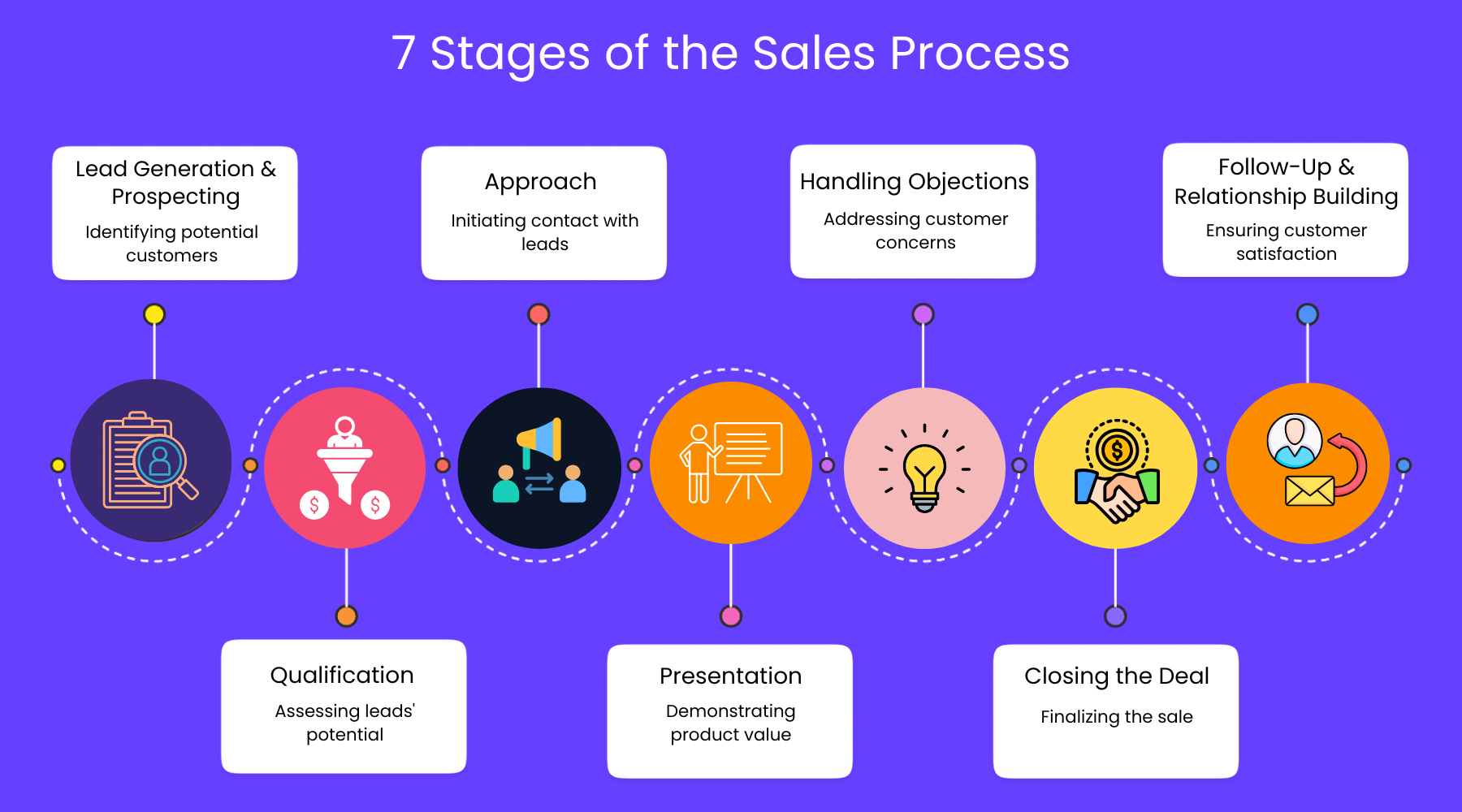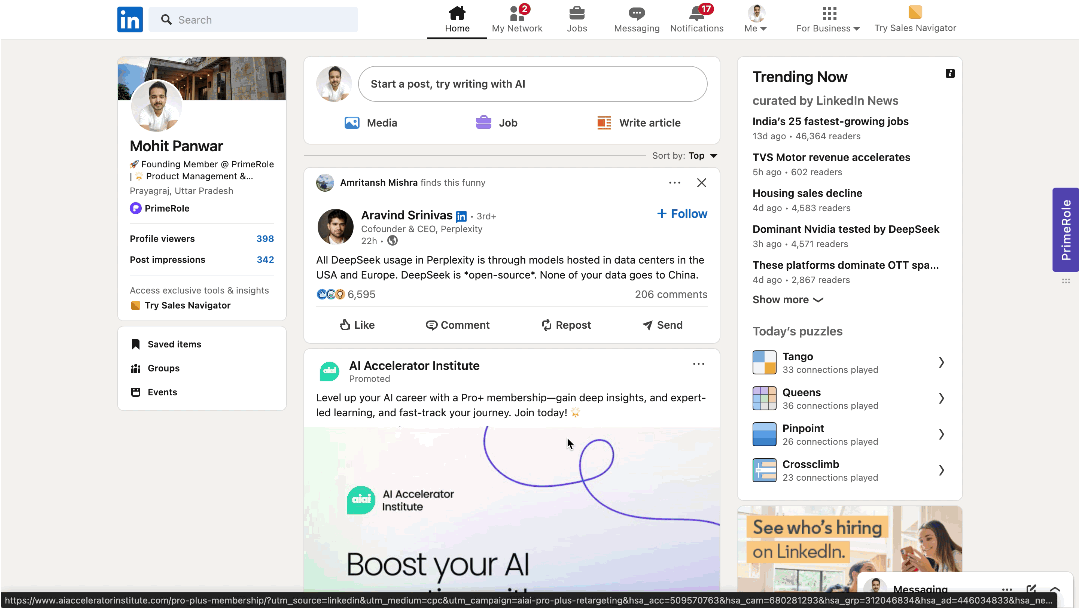
B2B Sales professionals know that even the best can have difficulty closing deals against potential leads. Whether in tech, healthcare, financial services, or other industries, you need to deploy different skills and strategies to convince would-be customers that your solution best fits their needs.
The seven-step sales process is a great foundation, but top-performing B2B sales teams understand that flexibility is essential. Rather than adherence to a script, they adjust their approach to each prospect's specific goals, pain points, and buying experience, resulting in a smoother path through the sales funnel and increased conversion rates.
Table of Contents:
- What is a sales Process?
- Why is it Important to Create a Sales Process?
- Sales Process Vs. Sales Methodology
- 7 Stages of the Sales Process
- Strategies to Create an Effective and Structured Sales Process
- Conclusion
- Frequently Ask Questions (FAQs) on Sales Process
What is a sales process?
The sales process involves identifying potential buyers, closing deals, and building long-term relationships. It is a systematic approach that sales professionals follow to convert prospects into customers.
A successful sales process ensures consistency, improves efficiency, and increases the chances of closing deals successfully. It provides sales professionals with clear blueprints to follow, making it easier to manage leads, track progress, and optimize sales performance, ultimately leading to higher revenue and business growth.
Reach Your Ideal Prospects with Precision
Utilize PrimeRole's advanced tools to identify, target, and engage your perfect customers effortlessly.
Why is it Important to Create a Sales Process?
The successful sales process is critical for a company seeking to improve sales performance, increase revenue, and forge deeper customer relationships.
According to Harvard Business Review, businesses with a defined sales process can boost revenue by up to 28% compared to those without one.
Without a clear path, sales reps often struggle to track their progress, understand why deals fall through, and keep leads engaged. Here’s why creating a successful sales approach is important for success.
Keeps Sales Teams Focused and on Track
The successful sales process is the road map that guides sales reps to take specific actions at each stage. Sales teams with a defined path have minimized missed steps and reduced errors, allowing them to focus on moving leads through the sales pipeline. This increases efficiency and ultimately helps sales reps in taking steps to close deals with goals and purposes.
Gives Clear Visibility into Sales Progress
A structured sales process gives sales managers and reps visibility into the stage of each deal they’re working on and where it might be getting stuck. With this visibility, it’s easier to pinpoint problems, identify where additional support is necessary and take action quickly in order to drive deals through the pipeline. This transparency also allows resources to be focused on the most important areas, which can greatly improve sales outcomes.
Delivers a Consistent Customer Experience
Customers value consistency. When sales reps follow a standardized sales process, each interaction feels smooth, professional, and reliable. A consistent approach not only improves the customer experience but also builds trust, as customers know they’ll receive the same level of service at every touchpoint. This positive experience can turn one-time customers into loyal advocates, benefiting the company in the long term.
Deepens Understanding of Customer Needs
A well-structured sales process gives sales reps clarity on how to best respond to customer needs at each stage. When sales professionals understand precisely where a customer is in the process, they can anticipate questions, respond to concerns, and offer a solution that will resonate. This tailored method allows for the establishment of trust. It makes customers feel valued, ultimately improving the chances of closing a sale and creating more solid and long-term bonds.
Improves Lead Quality and Efficiency
A successful sales process helps sales teams to remain focused on quality leads rather than quantity leads. A defined sales process helps teams to eliminate unqualified leads early and spend time focusing on the more promising leads. As a result, this focus on the quality of leads increases conversion rates and reduces the overall sales cycle, making the process more efficient. Integrating lead scoring CRM can fine-tune this process by pinpointing the leads with the highest likelihood of conversion.
Enhances Sales Forecasting
A structured Process, helps sales managers to get a visibility of the sales funnel, enabling him to forecast revenue accurately. By documenting each stage of the sales, managers can more accurately predict revenue, goals for the team, and hold the team accountable to those metrics. This visibility allows the sales team to set targets that are realistic and consistent with the businesses growth strategy.
Sales Process Vs. Sales Methodology
| Aspect | Sales Process | Sales Methodology |
|---|---|---|
| Definition | The structured steps a sales team follows to close deals. | The overarching approach or philosophy guiding how the process is executed. |
| Focus | The "what"—specific actions taken during the sales cycle. | The "how"—techniques and strategies applied within the process. |
| Content Type | eBooks, whitepapers, case studies | Blog posts, videos, industry reports, infographics |
| Examples | Prospecting, presenting, handling objections, closing deals. | SPIN Selling, Challenger Sale, Solution Selling. |
| Flexibility | Typically standardized but can be adjusted based on customer behavior. | More adaptable and can be applied across different sales processes. |
| Measurement | Success is measured by conversion rates, revenue growth, and deal closures. | Effectiveness is measured by how well sales reps adopt and execute techniques. |
7 Stages of the Sales Process
A successful sales process typically consists of seven key steps. Let’s break them down:

1. Lead Generation and Prospecting
Prospecting is the first step in sales, where professionals identify potential customers who align with their products or services. This stage involves extensive research to pinpoint the right industries, markets, and individuals that align with the company’s offerings.
To generate leads, sales teams leverage multiple techniques, including cold calling, networking events, social media engagement, and email outreach. A well-executed prospecting strategy ensures a strong pipeline of potential customers, setting the stage for successful conversions.
Understanding your total addressable market and leveraging sales intelligence tools can streamline this process. Sales automation tools like ZoomInfo and Primerole enhance lead generation.

For example, PrimeRole streamlines B2B prospecting by providing AI-powered sales insights and verified contact data from multiple providers. Its waterfall enrichment process ensures unmatched contact coverage, while advanced verification methods eliminate bad data. By integrating real-time ICP matching and CRM-native solutions, It helps sales teams identify and engage ideal prospects effortlessly.
By adopting AI-driven prospecting tools, businesses can refine their outreach, minimize wasted efforts, and maximize their sales opportunities.
Supercharge Your Sales with Actionable Insights!
Transform your sales growth with PrimeRole verified data and AI-enriched company insights
2. Qualification
Not every lead is the right fit for your business. The qualification stage involves assessing whether a prospect has a genuine need for your product or service, the financial capacity to afford it, and the authority to make purchasing decisions.
By properly qualifying leads, sales teams can focus their efforts on high-potential prospects, improving efficiency and increasing the likelihood of closing deals.
3. Approach
Once you’ve identified and qualified your leads, it’s time to make contact. How you approach a prospect can greatly influence their perception of your business and their willingness to engage. A personalized and thoughtful outreach strategy can foster trust and open the door for meaningful conversations, enhancing the likelihood of a positive response.
Best Practices for Making a Strong First Impression:
- Customize your outreach based on the prospect’s needs and industry.
- Use storytelling to create a compelling narrative about your product.
- Build rapport by demonstrating genuine interest in their business.
4. Presentation
The stage in the sales process where you sell your product or services is the presentation stage. Instead of running through features, you need to relate to your prospect’s pain points and challenges. Do your research first and understand the prospect’s needs and concerns. Customizing your presentation to speak directly to these points shows that you’ve listened and that you actually care about helping to solve the problem. Describe how your product can change their lives in a way that mirrors how your customer would describe it themselves, using visuals or test location or story techniques that build interest in a personal way with your customers.
5. Handling Objections
Objection handling is an essential and critical component of the sales pipeline. Prospects may have doubts about pricing, whether the product is right for them, whether to choose the competition, or other reasons for hesitation. A confident salesperson not only anticipates objections but also embraces them as opportunities to reinforce the value of their offering. Active, empathetic listening is particularly important in these situations, as it validates the prospect’s concerns before addressing them.
Regardless of the circumstances, an effective way to respond to objections is to provide clear, concise, and well-considered solutions that leave the prospect feeling reassured about their purchase. This could involve showcasing testimonials from satisfied customers, offering free trial periods, or demonstrating ROI, for example. Handling objections with confidence and authority can significantly enhance trust and rapport right away.
6. Closing the Deal
The closing phase is where your efforts in the earlier stages come to fruition as you seek to secure the customer’s commitment. Different closing techniques can be used until needed. For example, you can use the “assumptive close,” which means you operate under the assumption the prospect has already made the decision to buy, asking them what they would like for their order.
You can also use scarcity-driven bonuses or time limits to prompt last-minute prospects to follow through with their decision. It’s equally important that you pay attention to verbal and nonverbal cues, so that you can adapt in the moment. Be prepared to review the highlights of the benefits outlined in the presentation before asking for the sale in order to solidify the value.
7. Follow-Up & Relationship Building
A successful sales process extends beyond merely closing the deal. Getting in touch with customers after they make a purchase is crucial to build trust and make sure they are happy with the product or service they received. Taking this step at this point shows them that you are invested in their success and, in turn, leaves them with the door to future sales, and referrals, always open.
Depending on the nature of the product and the overall sales experience, it is wise to create thoughtful follow up communication through emails, phone calls, or personal visits to simply check on the customer to see if they have any questions or concerns. Building a relationship is not a one-time event, so remain in contact over time; you might share helpful resources, insights, or special deals that meet the customer’s ongoing needs. The ability to build strong relationships can determine long-term success in sales, as satisfied customers tend to return and even become influencers in your field.
Strategies to Create an Effective and Structured Sales Process
A well-structured sales cycle is essential for a successful sales team. It provides a clear roadmap for a structured process for connecting with potential customers, guiding leads through the sales funnel, and ultimately closing sales deals more effectively. Here are the essential strategies to establish a sales process that pays off.
1. Define Your Ideal Customer Profile (ICP)
Defining your Ideal Customer Profile (ICP) is the first step in building a successful sales process. This is a detailed exercise in analyzing the characteristics of your best customers. However, when building your ICP, you need to consider a number of different factors, such as industry, company size, location, and revenue. Also, explore demographic factors such as age, gender, and income levels, where appropriate for your product.
This should also include behavioral characteristics, such as your ideal customers' buying behavior and choices. When you clearly understand your ideal customer, your sales team can direct their efforts to prospects who are more likely to convert, improving their efficiency and success rates.
2. Develop a Clear Sales Pipeline
A well-structured sales pipeline is essential for guiding prospects through the buying process. This pipeline outlines each phase the prospect moves through, from initial contact to final purchase. Common stages typically look like this:
- Prospecting: Identifying and reaching out to potential leads.
- Qualification: Evaluating leads to determine their potential.
- Proposal: Presenting tailored solutions and pricing options.
- Negotiation: Discussing terms to reach a mutual agreement.
- Conversion: Finalizing the sale and onboarding the customer.
By visualizing each stage, sales reps can better manage their time and resources, ensuring they know which leads require immediate attention and what actions to take at every point in the sales journey.
3. Implement AI-Powered Lead Scoring
Automating lead scoring ensures that sales teams focus on the most promising opportunities while reducing time spent on unqualified leads. PrimeRole’s enriched insights leverage AI to evaluate multiple data points, such as engagement signals, firm size, industry trends and real-time intent data.
By Utilizing machine learning algorithms help sales teams prioritize leads with the highest conversion potential, tailor outreach to relevant customers, and reduce the duration of sales cycles. This targeted strategy boosts efficiency and enhances conversion rates by engaging the prospects with the greatest potential to become long-term customers.
Qualify High-Value Prospects Instantly
Optimize lead scoring with PrimeRole’s AI-driven ICP qualification system
4. Personalize Outreach Strategies
Personalization is key in the contemporary sales landscape, where buyers expect tailored experiences. Instead of sending generic sales pitches, utilize customer data to customize your interactions. For instance, refer to specific pain points or needs identified during initial conversations, and showcase how your product can directly address those issues.
Personalized outreach can be realized through individualized emails, customized presentations, and targeted follow-up calls. This approach not only improves engagement but also builds a connection with prospects, ultimately leading to higher conversion rates.
5. Leverage Multi-Channel Engagement
To maximize engagement, adopt a multi-channel approach to your sales efforts. This means reaching out to prospects through various channels, such as email, social media, phone calls, and even in-person meetings.
Each prospect may have a preferred communication method, and utilizing multiple channels increases the chances of reaching them effectively. By creating touchpoints across different platforms, you not only enhance brand visibility but also build trust, making it more likely that prospects will consider your offerings.
6. Streamline Data Management and Integration
Efficient data management is pivotal for a structured sales process. Integrate your Customer Relationship Management (CRM) system with marketing automation and sales tools to maintain a centralized database of customer interactions.
This integration helps eliminate redundancy, fosters collaboration among team members, and ensures that sales reps have access to reliable, real-time insights. The ability to view the complete customer journey enables sales teams to make informed decisions and tailor their approaches more effectively.
7. Continuously Analyze and Optimize
Sales processes should never be left stagnant; they are in constant need of review and improvement. Set a schedule for reviewing performance metrics such as conversion rates, sales cycle length, and average deal size.
Focus on identifying bottlenecks in your sales process and collect feedback from your sales reps about what they believe needs improvement. Data-driven insights take the guesswork out of determining what needs to be adjusted in your sales strategies to be able to sustain the levels of effectiveness and adaptability in this fast-evolving start-up workspace.
Conclusion
A well-defined sales process is essential for guiding potential buyers through each stage effectively. It enhances efficiency, minimizes friction, and creates a predictable revenue stream. By adopting a systematic approach, businesses can refine workflows and improve deal closures.
With advanced AI-driven sales intelligence platforms like PrimeRole, companies can strengthen their sales efforts using verified contact data, real-time insights, and automated lead qualification. Investing in a robust selling strategy not only enhances team performance but also nurtures long-term customer relationships, ensuring sustained business growth. Now is the time to optimize your approach with the right tools and strategies in place!
Frequently Ask Questions (FAQs) on Sales Process
What is a Selling Process?
A selling process is the series of steps a salesperson takes to convert a prospect into a customer. It includes prospecting, engaging with potential buyers, presenting solutions, handling objections, closing the deal, and following up. A structured selling process ensures consistency and improves the chances of successful conversions.
What are the main steps in a sales process?
The main steps include prospecting, preparation, approach, presentation, handling objections, closing the deal, follow-up, and ongoing customer engagement for long-term relationships.
How to Automate the Sales Process?
Automating the sales process saves time and boosts efficiency. Businesses can use CRM software to track leads, automate follow-ups, and analyze sales data. Email automation, chatbots, and AI tools streamline communication and nurture leads, allowing sales teams to focus on building relationships and closing deals faster.
How can I improve my sales process?
To improve your sales process, track performance metrics, train your sales team, use CRM tools, and continuously refine each stage based on customer feedback.
